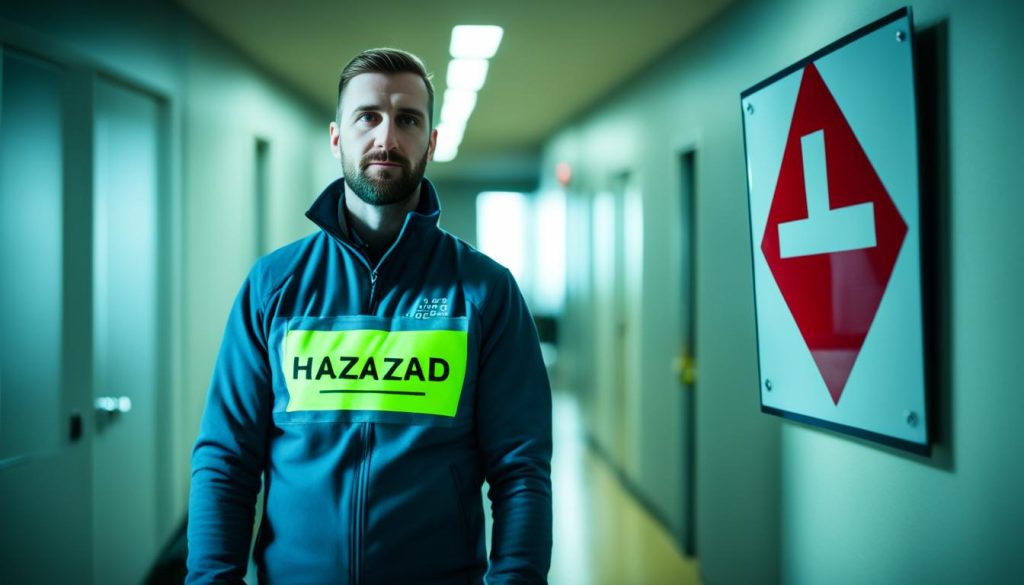If you’ve been hurt because someone wasn’t careful, you might be able to get money through a lawsuit. To win, you must prove four main things: duty of care, breach of duty, causation, and damages. This can be hard, but knowing how to prove negligence is key to getting the money you need for medical bills, lost wages, and other costs from the defendant’s mistake1.
Key Takeaways
- Personal injury cases need to prove four elements: duty of care, breach of duty, causation, and damages.
- Duty of care means having a legal promise to be careful to avoid hurting others.
- Breach of duty happens when someone doesn’t act as they should, leading to possible negligence claims.
- Causation means the defendant’s mistake directly caused the plaintiff’s injuries.
- Damages include medical bills, lost wages, pain and suffering, and other losses.
What is Negligence in Personal Injury Cases?
Negligence is a key idea in personal injury law. It happens when someone doesn’t act as a reasonable person would in a similar situation, causing harm to another2. If someone’s actions or lack of action are below what’s expected, and this causes an injury, they might be legally responsible for the damage2.
Types of Negligence
There are two main kinds of wrongs that can lead to personal injury cases: intentional and accidental ones2. Intentional torts are when someone means to cause harm, like in assault or battery. Accidental torts are when someone doesn’t mean to hurt anyone but still causes an injury because they didn’t meet their duty of care2.
To win a personal injury case, the plaintiff must show the defendant didn’t meet their duty of care3. This means they didn’t act in a way that would keep others safe3. The plaintiff also needs to prove that this failure caused their injuries and any damages they suffered3.
“Negligence is the failure to use such care as a reasonably prudent and careful person would use under similar circumstances.”4
The level of care expected can change based on the situation and the relationship between people3. For instance, doctors and other healthcare workers are expected to know more and act differently than regular people because they have special training3.
Knowing about negligence and its types helps personal injury victims understand their legal rights. This knowledge can help them build a strong case to get the compensation they need342.
The Four Elements of Proving Negligence
Duty of Care
To win a negligence lawsuit, the plaintiff must prove four key points: duty of care, breach of duty, causation, and damages5. The duty of care means a person or organization must act safely to avoid harming others, like a driver driving carefully5. Most of the time, this part is not debated in personal injury cases, showing it’s often accepted6.
The Hand Formula is used in some U.S. courts to check if someone has broken their duty of care7. It says if it’s easier to prevent harm (B) than the chance of harm (P) times the severity of harm (L), then there was a breach7. In some cases, emotional distress can be seen as harm, even if it’s just mental and not physical7.
| Element | Description |
|---|---|
| Duty of Care | The legal responsibility of a person or organization to avoid actions that could potentially harm others. |
| Breach of Duty | When the defendant’s actions or inactions fail to meet the required standard of care, leading to the plaintiff’s injury. |
| Causation | The causal link between the defendant’s breach of duty and the plaintiff’s injury or damages. |
| Damages | The quantifiable harm or losses suffered by the plaintiff as a result of the defendant’s negligence. |
Having solid evidence can make settling claims faster, showing how important evidence is in personal injury cases6. Medical bills show how severe an injury is and are key in figuring out how much to settle for6. Expert opinions, like from doctors, are vital in court, proving the need for expert evidence in negligence cases6.

It’s wise to hire a personal injury lawyer for many reasons, like getting full payment for medical costs, lost wages, and expert help in court657.
proving negligence, personal injury, legal proof
Proving negligence is key in personal injury law. The plaintiff must show four main things: breach of duty, causation, standard of care, and damages89.
A breach of duty happens when someone or something fails to meet their duty of care, causing harm8. Causation means showing a direct link between the defendant’s actions and the plaintiff’s injuries8. The plaintiff must prove the defendant’s actions were the main cause of the injury and that the injury was likely to happen8.
Immunity or jurisdiction issues can make it hard for the plaintiff to sue8. Negligent actions include driving drunk, not keeping property safe, or not keeping dangerous animals under control8.
Negligence is a big deal in personal injury law. It means defendants can be legally responsible for the harm they cause by not being careful enough8. Lawyers for personal injuries are key in proving negligence. They gather evidence, document injuries, figure out damages, and talk settlements for those hurt8.
| Element | Description |
|---|---|
| Duty of Care | The legal obligation to exercise a reasonable standard of care to avoid causing harm to others. |
| Breach of Duty | The failure to meet the expected standard of care, resulting in harm to the plaintiff. |
| Causation | The direct link between the defendant’s negligent actions and the plaintiff’s injuries. |
| Damages | The quantifiable harm, such as medical expenses, lost wages, and pain and suffering, suffered by the plaintiff. |
In Texas, negligence laws differ by state. Texas uses a system where plaintiffs can still get money even if they’re partly to blame, but they get less if they’re partly to blame8.
Personal injury cases can include different types of damages. Special damages are things you can put a price on like medical bills and lost wages. General damages are for things you can’t put a price on like pain and suffering. Punitive damages are to punish the defendant for really bad behavior8.
To prove negligence in Texas, you need to show duty, breach, causation, and damages8. In Kentucky, you also need to prove duty, breach, causation, and damages10. In Kentucky, the plaintiff must prove each part by having more evidence than not10.

Evidence is key in proving negligence and showing who is liable9. Things like eyewitness stories, medical records, and accident reports help build a strong case9. Having a lawyer can help with the legal stuff and increase your chances of winning9.
“Negligence is a central element in personal injury law cases.”9
Evidence and Damages in Negligence Claims
To prove negligence in a personal injury case, the plaintiff must show strong evidence for duty, breach, causation, and damages11. This evidence can be police reports, medical records, photos, surveillance footage, and testimony from witnesses and experts12.
If the plaintiff proves negligence, they can get three types of damages: special, general, and punitive damages13. Special damages are for things you can put a price on, like medical bills and lost wages. General damages cover things you can’t put a price on, like pain and emotional distress. Punitive damages are for really bad behavior, meant to punish and stop others from doing the same13.
It’s key to gather and present strong evidence to show how much the plaintiff was hurt and to support the negligence claim12. This might mean getting medical records, accident reports, and eyewitness stories. Experts can also help by looking into the incident and its effects on the plaintiff12.
| Type of Damages | Description |
|---|---|
| Special Damages | Quantifiable monetary losses, such as medical expenses and lost income. |
| General Damages | Non-economic harms, including pain, suffering, and emotional distress. |
| Punitive Damages | Awarded to punish the defendant’s egregious conduct and deter similar behavior. |
By collecting and presenting strong evidence, the plaintiff can boost their chances of getting the right damages and proving negligence1213.

“Collecting and preserving evidence is crucial in demonstrating the extent of the plaintiff’s losses and strengthening their negligence claim.”
Conclusion
Proving negligence is key to getting the right compensation for medical bills, lost wages, pain, and other losses14. You need to show the four main parts: duty, breach, causation, and damages. This way, you can prove the other person was legally at fault for your injury1415.
Having a skilled personal injury lawyer is a big help. They guide you through the complex process of building a strong case. They make sure you meet the deadline set by the law16. They also use expert witnesses to support your case, especially in 42% of cases16.
Personal injury cases come in many forms, like car accidents, slips, and medical mistakes16. Knowing how to prove negligence can boost your chances of getting fair compensation. It also makes the guilty party take responsibility for what they did1415.
FAQ
What is negligence in personal injury cases?
Negligence means not doing what a reasonable person would do in a similar situation. This can lead to harm or injury to someone else. There are two main types: intentional torts, where someone causes injury on purpose, and accidental torts from negligence.
What are the four key elements of proving negligence?
To prove negligence, you need to show four things: (1) the defendant had a duty to the plaintiff, (2) they didn’t meet that duty, (3) their failure caused the injury, and (4) the injury caused real harm.
How do you prove breach of duty in a negligence case?
Proving breach of duty means showing someone or something didn’t meet their duty of care, causing harm. You must show the defendant didn’t act like a reasonable person would in the same situation.
What types of evidence are used to prove negligence?
Evidence like police reports, medical records, photos, videos, and witness and expert testimony helps prove negligence. If successful, you can get back money for special, general, and punitive damages.
What challenges can plaintiffs face when trying to prove negligence?
Plaintiffs might face issues with immunity or jurisdiction, making it hard to sue. They also need to show a clear link between the defendant’s actions and their injuries. Plus, they must prove the harm was likely to happen.
Source Links
- Injury Law Group
- What Is Proof of Negligence in a Personal Injury Case?
- Proving Negligence in Personal Injury Cases | California
- How to Prove Negligence – 4 Elements You Need to Establish
- 4 Elements Necessary to Establish a Successful Negligence Claim | Harrington Hoppe & Mitchell
- Proving the Four Elements of Negligence
- negligence
- How To Prove Negligence In A Personal Injury Case
- How Do I Prove Negligence in a Personal Injury Lawsuit? | Clark Frost Zucchi | Premises Liability Attorney Rockford
- How to Prove Negligence in a Personal Injury Claim
- How to prove negligence in a personal injury case?
- What Evidence Is Needed to Prove a Personal Injury Claim?
- Elements to Prove Negligence In a Personal Injury Claim – Muth Law, PC
- How to Prove Negligence in a Personal Injury Lawsuit | Injured CT
- Expert Tips: Proving Negligence in a Personal Injury Claim
- Understanding the Process of Proving Negligence in a Personal Injury Case

